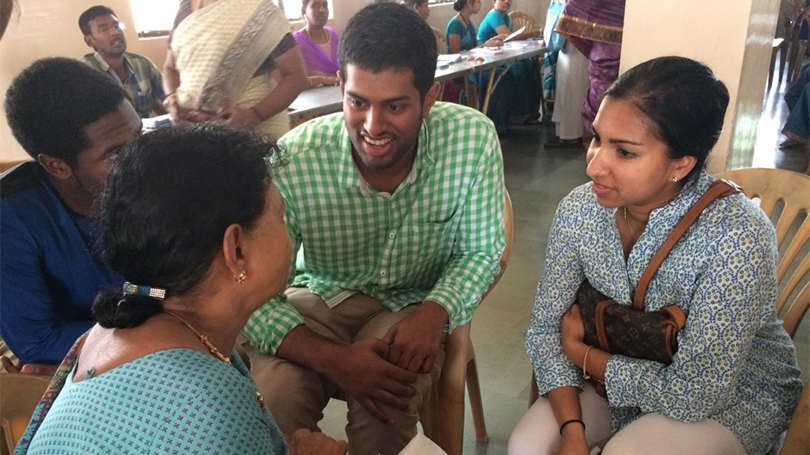
- About
- Consultation
- Programs
- Resources
- News & Events
Back to Top Nav
Back to Top Nav
Back to Top Nav
“Embedded” courses expand students’ learning off campus, applying theories to practice.
At the end of fall term, most students headed for home. But for some, school wasn’t over yet. These students were embarking on trips to see how theories discussed in class relate to the way life actually works in countries very different from their own.
“The idea in these embedded courses is that you can see in practice the kinds of things you have been studying,” says Michael Mastanduno, dean of the faculty of arts and sciences. “So, for example, in an economics course you might have run into questions like, ‘What is the relationship between industry, labor, and government in launching an emerging economy?’ Then you could go to Peru or Poland to meet workers and labor leaders—maybe business executives and government officials—calibrating what they are saying against what you were taught in class.”
That is exactly what students did when they accompanied Elisabeth Curtis, a senior lecturer in economics, to Poland at the end of fall term.
Professor Diego Comin’s economics class “Inclusive Growth in China” spent a few weeks in the world’s most populous country. According to the course description, “People are ultimately what we care about as social scientists. Therefore, we will make a central goal of the off-campus portion of ‘ECON 70’ to meet the local population and understand how their aspirations and livelihoods adapt to the new country they face every day.”
South Africa was the destination for students in an anthropology class co-taught by Jeremy DeSilva and Nathaniel Dominy. They visited caves where recent discoveries about our human ancestors made international headlines.
Ten undergraduate biology students and one PhD candidate ended the term by visiting the Aravind Eye Hospital in Madurai, India, which has an ongoing partnership with Thayer School of Engineering and The Dartmouth Institute (TDI).
The biology class visited the Aravind facilities to present their own research and to observe the delivery of eye care in India. Co-taught by Adjunct Professor Michael Zegans, also a professor of surgery at the Geisel School of Medicine, and Dawn Carey, director of TDI's Learning Lab, the students toured the eye hospital, labs, and manufacturing and training centers. They also made time for side trips to temples and other ancient sites.
The students took turns writing a daily blog with their own photographs. Here is an entry for Dec. 6, written by Tammy Hua ’17, about surgical procedures at Aravind:
We watched the surgeons perform through these giant glass panels in the OR. The first major difference we noted was that each room had three patient beds (although only two were in use at a time when we were observing). The multiple beds allowed the nurses to prepare the next patient as the surgeon completed the surgery. As the resident and fellow explained what was happening inside, Dr. Zegans would recount to us what would be done differently in the U.S. We were able to observe a variety of procedures, even though they were all cataract surgeries, owing to the diverse patient population at Aravind. Some of what we saw included phacoemulsification, small incision removal, and even watching a surgeon adroitly manage a complication with the vitreous humor. The most prolific ophthalmologists in the U.S. performed about 600 cataract surgeries per year, whereas the Aravind ophthalmologists performed 170 cataract surgeries per day. Amazing!

Informative blogs are an excellent way for students to record and share what they are learning on these trips, says Ashley Kehoe, associate director of experiential learning at the Dartmouth Center for the Advancement of Learning (DCAL). “Reflection is the key to making connections between academic learning and off-campus field study,” she says.
Kehoe says embedded courses are increasingly popular at Dartmouth—as are semester-long study-abroad programs. She says the College is trying to expand fieldwork opportunities for students who may not have the time or resources to spend an entire term off campus.
“We offer short-term experiences, long-term experiences, foreign travel, domestic travel—and I think that wide spectrum of experiential learning is what sets Dartmouth apart from peer institutions,” says Kehoe. “Research shows that learning outside the classroom can foster creativity, collaboration, confidence, resiliency, self-awareness, and the ability to scale cultural barriers,” Kehoe says.
Mastanduno says more and more faculty are taking advantage of the “winterim”—the interval between fall and winter terms—by proposing embedded courses to the arts and sciences faculty committee on instruction, which must grant approval. A few courses between winter and spring terms will also involve travel. Funding comes from DCAL, which currently gets more requests than it can grant. Students in courses that include an off-campus component must agree, when they enroll, to add a few weeks to their term for travel. Dartmouth covers their expenses.